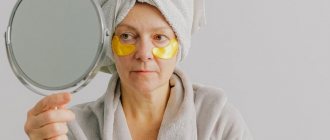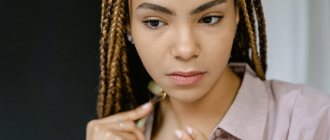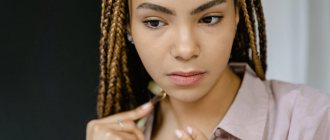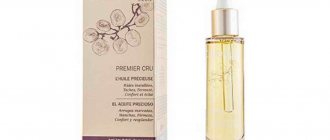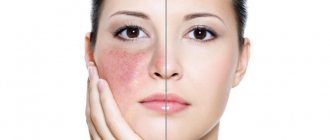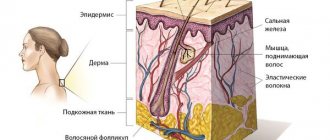Over the last decade, the problem of hand skin aesthetics has attracted increased attention from both patients and cosmetologists.
The skin of the hands is subject to the aggressive influence of a variety of external factors: UV irradiation, cold, water, household chemicals. In combination with internal aging factors, this leads to a fairly early appearance of involutive changes in this zone: pigmentation, thinning, wrinkling and dryness of the skin, tissue atrophy with visualization of veins and tendons [1, 2].
In 2006, R. Bains et al. conducted a survey of opinions, analyzed more than 300 clinical cases and came to the conclusion that a person’s age can be determined by looking at his hands. External signs of aging of the skin on the dorsum of the hand play an important role among the objective markers of general aging [3].
Correction of age-related changes in the skin of the hand requires the use of a comprehensive program [4].
The use of multidirectional techniques that provide replenishment of soft tissue volume (introduction of fillers, autologous fat), improvement of the visco-elastic properties of the skin (use of revitalizants), correction of signs of photodamage (hardware technologies, chemical peels, bleaching agents), allows us to obtain long-lasting results and patient satisfaction [ 3, 5, 6].
However, only a few authors have studied the essence of aging of the skin of the hands [4, 5, 7, 8].
To analyze the main signs of aging and choose the optimal rejuvenation method, it is necessary to determine which path the aging of a given delicate area takes [1]. Foreign specialists began to actively study the aging processes of the skin of the hands only in the last decade. In our country, this direction is also becoming increasingly popular.
The first qualitative study to determine chronological changes during aging of hand skin in individuals of phototypes I-III according to the Fitzpatrick classification was presented by Jakubietz et al. in 2008. In the course of studying age-related changes in the skin of the hands, the authors concluded that in both sexes there is a clear and predictable progression of wrinkling of the skin of the hands, that the aging process affects mainly the dorsal surface, and the skin of the palm is subject to only minor changes. Researchers have noted a strong positive correlation between visual signs of aging and age [4, 9].
An interesting fact is that it is the tortuosity of the veins on the dorsum of the hand that determines a person’s age to a greater extent than their number. Joint deformities are also a sign of aging, but this cannot be said with certainty about tendons, the visualization of which is not necessarily related to age. In addition, the authors noted that the dominant hand is characterized by pronounced venostasis and a square shape of the dorsum of the hand, which is observed in individuals of both sexes. According to a survey, women prefer the appearance of their non-dominant hand, while men prefer the appearance of their dominant hand [1, 4, 5].
Jakubietz et al. In the course of studies aimed at studying the mechanisms of age-related changes in this area, two types of aging of the hands were identified, namely external and internal. The external type of aging includes disorders in the epidermis and dermis, which is associated with photoaging and elastosis. The internal type includes atrophy of subcutaneous fat, changes in deeper structures with visualization of tendons and veins [4, 10].
Standardization of the assessment system in the analysis of age-related changes is a pressing topic for objectifying the results obtained after anti-aging therapy.
Most practitioners who evaluate the results of treatment rely on the analysis of photographs before and after the intervention, which is partly subjective. This principle is not suitable for the systematic accumulation of material in research work, the purpose of which is to analyze practical experience and develop preventive measures regarding the aging of soft tissues of the hand. To select a personalized approach with a prognostic outcome, it is necessary to use simple objective tools, such as visual scales [1, 9].
Validated hand aging scale
Generally accepted rating scales could become the basis for systematization and objectification of the results and effectiveness of the procedures performed. Therefore, it is important for researchers and practitioners to find an optimal and convenient tool for assessing aesthetic results. For this purpose, we analyzed and assessed the types of aging using existing scales [3, 4, 9].
Carruthers et al. in 2008, they proposed a 5-point visual aging scale (VAS) for an objective quantitative assessment of the degree of age-related changes in the hands, monitoring the results of rejuvenation procedures and for other scientific and practical purposes in the field of aesthetic medicine (Fig. 1)
Rice. 1. Validated 5-point Merz hand aging scale. [eleven]. VFS reflects the degree of loss of subcutaneous fat (SFA), the degree of visualization of veins and tendons. An undoubted advantage is the visibility of age-related changes, which are depicted on aesthetically attractive hands, even with the help of a photo editor. Nevertheless, this scale paves the way for effective and objective communication of information in clinical research [1].
The pigmentation and quality of the skin on the dorsum of the hand are not described, and body mass index (BMI) is not taken into account. Namely, this determines the path along which aging of the dorsal surface of the hand will develop. In our opinion, it is BMI and body type that can influence the main signs of aging in this area.
To analyze the signs of aging and present the chronology of aging of the hands, we studied complaints and clinical signs of age-related changes in patients who sought cosmetic help (Fig. 2).
Rice. 2. Frequency of complaints.
Material and methods
To identify and describe various morphotypes of aging, we developed a questionnaire consisting of four blocks of questions that revealed information about heredity, morphometric data, clinical signs of aging, self-assessment of the condition of the skin and soft tissues of the hands. A 10-point rating system was used, in which the significance of a feature was determined from 0 to 10 (with explanations). The questionnaire was filled out by the patient and an independent medical expert. Filling out the questionnaire took about 5 minutes.
We also collected information about hand dominance at work, profession, preference for using the right or left hand, calculated BMI, and determined the morphotype of aging in interviewed individuals over the age of 40.
At the Vallex Med clinic, from November 2014 to November 2016, a study was conducted in which 310 healthy women of the Slavic type who were cosmetology patients took part. Questionnaires and questionnaires for the subjects were approved by the ethics committee of the Vallex Med clinic.
Inclusion criteria: healthy women aged 25-65 years of Slavic type, I-III phototype, with a BMI of 18-30 kg/m2.
Exclusion criteria: skin, rheumatic diseases, gout, deforming arthritis, various types of injuries to the hands (burns, fractures, scars in the hand area, neurovascular disorders), previously performed cosmetic procedures in the area of the back of the hands.
Standard photography of both hands was performed in oblique radial and dorsal projections in full size, as well as from above during flexion, in the same room with constant temperature and lighting, with the same camera. The photographs were assessed by the same expert (cosmetologist) using the merz scale.
The photographs were assessed and the dominant signs of aging for each participant were identified.
Subjects were weighed and height measured to determine BMI. Next, we measured the length and width of the brush; wrist circumference. Information was collected about the dominant hand, the time of appearance of signs of aging in the area of the back of the hands, and the hereditary nature of skin aging in this area.
At the next stage, the severity of contouring of veins and tendons, loss of volume of the pancreas, and pigmentation were assessed.
The most standard options for aging brushes were selected, and trends in brush aging were determined from photographs.
Test to determine wrinkles and sagging.
The patient's skin was gathered into a fold in the center of the back of the hand (above the area of the third finger) in the longitudinal and transverse direction (pinch test). They raised it above the level of the back of the hands and measured the time during which the skin returned to its original position, and also measured its thickness using a caliper with an accuracy of 0.2 mm.
General information
Skin atrophy refers to irreversible changes in the skin, a decrease in its volume and qualitative functional disorders of tissues, in particular elastic fibers.
The pathology refers to the group of chronic heterogeneous skin lesions, as a result of which, against the background of a decrease in the level of functional abilities (protective, regulatory, excretory, etc.), thinning of previously fully formed skin elements occurs, including the epidermis, dermis, appendages, and in some cases – and subcutaneous fatty tissue. Externally, the skin looks dry, flaky, translucent, wrinkled, sensitive, strongly folded, loses hair and telangiectasias . If connective tissue structures grow, focal compactions may occur.
results
Individual hand dominance and preference for using the right or left hand were also analyzed. In 304 (98%) women, the right hand was dominant, in 7 (2%) the left hand was dominant.
300 (96.5%) women preferred to use the non-dominant hand, which is more aesthetically pleasing. Since the dominant hand is used mainly for physical labor, it can be expected to age at an accelerated rate. When surveyed, the majority were aware that hands differ in appearance, but most did not attach any importance to this. In the hand of the dominant hand, congestion, veins, and muscles were more pronounced, and the shape was more reminiscent of a square.
Women placed more importance on the aesthetic appeal of the non-dominant hand.
Among the proposed eight signs that define an “aging hand,” patients identified four main ones: age spots, contouring of veins and tendons, sagging/wrinkling, thinning of the skin (in 87, 84, 78 and 76%, respectively).
In this study, a group of women over 40 years of age was identified ( n
=208) with signs of chrono- and photoaging, three main
morphotypes of aging
of the dorsum of the hand were identified, correlated with age, BMI, and fold thickness (Fig. 3).
Rice.
3. Morphotypes of hand aging. The morphotype of hand aging is a set of constitutional and age-related features of the dorsum of the hand, including shape-forming characteristics, involutional changes in the skin, the severity of subcutaneous tissue atrophy, visualization of veins and tendons.
Type I - atrophic/asthenic morphotype
(31%,
n
=134) occurs in women with an asthenic type of constitution and a BMI of 18-19 kg/m2 of veins and tendons. The skin fold of the dorsum of the hands is thin (1-2 mm), the skin is thinned, dry, wrinkled, subcutaneous fat tissue (SFA) is poorly developed. With the pinch test, the skin straightens out in 4-8 seconds. The circular folds in the wrist area are thin and shallow. The longitudinal size of the rear of the hands, as a rule, prevails over the transverse one, the phalanges are long or of medium length.
In this type, patients with venous and tendon components can be distinguished.
Venous component
very pronounced (for a correct assessment of the filling of the venous network, the study subjects were seated vertically, with the arm bent at the elbow joint at an angle of 90°).
Characteristic is the tortuosity of the vessels, which increases with age, and incomplete emptying of the veins is observed during flexion of the fingers.
During the survey, we found that 45% of women do not associate veins with age. Flexor tendon contouring and venous tortuosity (venotendinous subtype) have been found to be genetically determined; Features of the back of the hand attracted attention already at a young age and were found in the mother. This subtype in our study was identified only in 7.9% ( n
=8).
During the survey, many women noted that the pattern of the dorsal veins changes little with age. The severity of the veins increases from physical activity, after wearing heavy objects, and also due to the characteristics of the profession (the hands of a pianist, violinist, waitress, cleaner).
It was noted that atrophic changes in the tissues of the dorsum of the hands with contouring of the tendons occur closer to the metacarpophalangeal joints.
Tendon component
: tendons are visible on the back of the hand, especially clearly visualized above the center of the metacarpophalangeal joints of the II-IV fingers, especially noticeable during flexion. A direct correlation between the progression of the degree of aging and age was revealed.
Type II - normotrophic morphotype
(48.1%,
n
= 154) occurs in normosthenics with a BMI of 19-24 kg/m2, less often in asthenics. The skin is thin, the skin fold is of medium thickness (2-2.5 mm), with a pinch test it straightens out in 5-7 seconds. The pancreas is moderately developed. Veins and tendons are poorly or moderately visualized. The venous component is often due to genetic or occupational characteristics. During flexion of the fingers, the dorsal veins are completely emptied. With age, multiple transverse flexion folds over the proximal interphalangeal joints (PIP) and a separate fold over the distal interphalangeal joints (DIP) may occur. The circular folds of the wrist are more pronounced. The longitudinal and transverse dimensions of the rear of the hands are close or the longitudinal one slightly predominates, the phalanx is of medium length.
Symptoms of sagging, dry skin, according to our observations and according to patient complaints, appear and progress after 50 years. It is the deterioration of skin quality due to a decrease in its visco-elastic properties that worries patients with this type of aging of the hands.
Type III - hypertrophic morphotype
(20.4%,
n
=23) occurs in women with a hypersthenic build, with a BMI of 25-30 kg/m2. The subcutaneous fat layer of the dorsum of the hands is also well expressed both on the face and torso. The skin fold is difficult to grip and its thickness is above average (2.5-4 mm). The fold quickly (within 3-4 s) returns to its original state, completely straightening out. In the hands of overweight people (BMI>27 kg/m2), there is more superficial fat in the dorsal superficial plate, which masks veins and other deep structures.
Veins and tendons are practically not visualized. Multiple transverse flexion folds over the PIP and a single fold over the DIP may occur. The back of the hands is characterized by a square shape, the phalanges are short or medium in length.
Wrinkles are weakly expressed and dynamic in nature.
Patients of this type of hand aging are the least likely to seek cosmetic treatment for this area. To restore skin moisture and elasticity, short courses of biorevitalization with stabilized hyaluronic acid preparations can be recommended. Fillers are not recommended for this type.
We noted that signs of photodamage to the skin (dullness, pigmentation, lentigo) occur in all identified types of aging. Their number increases with age and does not depend on BMI; they correlate with age and photoaging of the face (see Fig. 3). The number of age spots increases with age (high positive correlation coefficient). Single age spots may first appear in the fourth decade; later they merge with each other, increasing in size and number. After 60 years, the spots are quite numerous (Fig. 4).
Rice. 4. BMI and stage of aging.
Clinical differences in morphotypes of aging hands are presented in the table.
Clinical differences in morphotypes of aging hands Note. + - mild degree of severity of the symptom; ++ - average degree; +++ - pronounced degree.
Recommendations for thin facial skin
It is very important to properly care for your facial skin every day, so you should follow certain expert advice:
- do not use ordinary soap, it is better to take special milk or gel;
- do not go to bed with makeup on your face;
- regularly use masks and creams;
- the products should not contain aggressive, alcohol-containing components;
- remove salty, fried, spicy foods from the diet, and add more nuts, vegetables, fruits;
- do not perform aromatherapy, do not make herbal compresses, do not use cosmetic ice;
- Do not stay in the sun for too long, do bath procedures, or visit the sauna;
- sleep enough time so that cells can renew and recover;
- control your facial expressions, try not to wrinkle your forehead or squint your eyes;
- drink plenty of water;
- use sunscreen;
- If you decide to do peeling, then use exfoliating microgranules of artificial origin. They will injure the skin less.
Discussion
When a patient presents with an asthenic type of aging of the hands, it is recommended to carry out correction of the “skeletal hand”, taking into account the identified features. Autologous fat, fillers of various natures, and revitalizants are used to fill tissues [1, 9, 12, 13].
There is a wide variety of fillers based on HA of varying viscosity, which allows you to choose the most suitable drug adapted to age-related problems [9, 12-17]. In 2012-2014 In our own works (in double-blind and placebo-controlled studies to study the effectiveness of intradermal injections of revitalizants), we have shown the high clinical effectiveness of 3-fold administration of stabilized HA gel (20 mg/ml HA), increasing the elasticity and hydration of the skin on the back of the hands. The procedure for rejuvenating the skin of the hands is generally well tolerated, accompanied by mild pain, swelling and ecchymosis. The skin becomes significantly less rough, less wrinkled, and more hydrated. The clinical effect lasts up to 6 months with a gradual decrease by the 12th month (Fig. 5)
Rice. 5. Atrophic morphotype of aging. Photo of the hands of a 50-year-old patient: before the procedure, on the left is a drug based on stabilized HA with a concentration of 18 mg/ml. a - saline solution on the right; b - after 3 months. [13, 18].
For patients with a normotrophic type of hand aging, procedures are recommended aimed at improving the visco-elastic properties of the skin: fractional photothermolysis, microneedle radio wave lifting, biorevitalization with preparations of unstabilized HA and amino acid complexes, calcium hydroxyapatite. The accumulated almost 13-year experience of using revitalizants based on stabilized HA confirms the high safety profile and commitment of aesthetic medicine doctors to the method [7-11, 16, 17]. It has been proven that this group of drugs not only provides long-term tissue hydration, but also promotes the restructuring of the intercellular matrix of the dermis, which has a positive effect on the appearance and biomechanical properties of the skin [18-21].
When a patient presents with a hypertrophic type of hand aging, cosmetic correction is aimed at eliminating the identified signs of chrono- and photoaging, which are usually mild or moderate. Improving skin tone and elasticity through mesotherapy may be recommended. The emphasis of rejuvenation is on improving skin microrelief and correcting pigmentation. When correcting dry, wrinkled skin, preparations based on unstabilized HA (HA concentration 20 mg/ml) are recommended (Fig. 6)
Rice. 6. Normotrophic morphotype of aging. Correction of age-related changes with calcium hydroxyapatite. [1, 22-25].
Causes of atrophic dermatitis
The main causes of atrophy include:
- Aging is the most common cause of natural atrophy of the body, which is manifested by the appearance of wrinkles, loss of elasticity, dryness and a tendency to injury,
- Sunlight can cause atrophy. UVA and UVB rays damage skin cells,
- Alcohol and smoking accelerate the aging process and lead to thinning,
- Steroid creams and ointments cause a decrease in the size of epithelial cells and weaken the connections between them.
The main cause of atrophic dermatitis is the side effect of ointments and creams containing glucocorticosteroid hormones. This effect can be explained by the fact that cell division slows down and the structural proteins of the skin are destroyed. Adrenal cortex preparations are very widely used in dermatology; they are used to treat many pathological processes, such as atopic and contact dermatitis, eczema, allergies, psoriasis, and also as adjuncts in the treatment of skin manifestations of systemic diseases, lupus erythematosus, neurodermatitis, rheumatoid arthritis.
Weaker drugs are freely available, and patients with any skin problem can purchase them at the pharmacy and are treated with them without doctor supervision for a long time. More powerful ointments prescribed by a doctor cause atrophic changes after two to three weeks of use. The most powerful agents can lead to thinning of the dermis after three days. The positive effect of steroid hormones can be negated by this side effect, since the barrier role of the epidermis is significantly reduced, which leads to large fluid loss, irritation and symptoms of dry eczema.
Prevention
The main preventive measure to prevent the development of secondary pathological atrophy of the skin is timely effective treatment of the initial disease, as well as:
- protection with SPF creams from excessive sun exposure;
- use of corticosteroid drugs under the supervision of a physician;
- avoiding long walks;
- choosing the most closed clothing made from natural fibers;
- using only high-quality cosmetics;
- healthy lifestyle;
- quitting smoking and drugs.
Treatment
Conservative therapy
The tactics of conservative therapy are determined by the etiology of the coarsening of facial features:
- Acromegaly
. To normalize the level of somatotropic hormone, somatostatin analogues are used. Patients are prescribed dopamine agonists, sex hormones, radiation therapy or gamma therapy to the pituitary gland. - Masculinization
. For virile syndrome, glucocorticosteroids, antiestrogens, and biguanides can be used. Women with hyperandrogenism are recommended to take oral contraceptives that provide an antiandrogenic effect. - Mucopolysaccharidoses
. Treatment is symptomatic only, the treatment program is determined taking into account existing disorders, and may include the prevention of respiratory infections, correction of hearing and vision impairment. - Leprosy
. The basis of treatment is long courses of sulfone drugs with their periodic replacement. Adaptogens, vitamins, immunocorrectors, antibiotics, and hepatoprotectors are indicated. To maximize the preservation of the functions of the musculoskeletal system, mechanotherapy, massage, and exercise therapy are performed. - Alcoholism
. For alcohol dependence, medicinal and non-medicinal coding, psychotherapeutic influence, and social rehabilitation are carried out.
Home skin care
Home skin care is an integral part of the therapy for involutional skin changes during menopause. To solve the problem of hormonal aging of the skin, certain substances of plant origin are of particular interest - isoflavones, which exhibit estrogen-like properties. When applied cutaneously, they exhibit estrogen-like activity in relation to the skin, but do not affect the hormonal status of the body as a whole. They also have an antiandrogenic effect by blocking the enzyme 5-alpha reductase, which is why isoflavones are included in acne treatment products.
Renophase laboratory (France) rightfully occupies one of the leading places in the modern cosmetology world and offers a wide selection of highly concentrated products for home care based on soy and wild yam. The preparations are easy to use, have a light texture, and their composition is as close as possible to professional products. Home care products are selected by a cosmetologist after consultation and skin diagnosis. The minimum set includes makeup remover (gel or milk), day and night cream, and eye cream.
The cosmetic line for home care Dermaheal (South Korea) contains dozens of different types of peptides, cytokines, growth factors, immunomodulators, which make it possible to stop and reverse the processes of biological and physiological aging of the skin. Penetration of active ingredients is carried out thanks to nanoencapsulation technology. When growth factors are introduced into mature skin, wrinkles are reduced due to the activation of the division of its own cells, skin elasticity increases due to the restoration of the synthesis of collagen, elastin, hyaluronic acid and other components of the extracellular matrix, the pH of the skin is normalized, as well as the function of the sebaceous glands.
In the arsenal of modern cosmetology there are methods and technologies that can help women of the “second transitional age” maintain healthy and beautiful skin. The combination of home care and professional procedures allows you to achieve excellent results in a relatively short time.
In men
The male penis may undergo atrophy and shrinkage of the glans, as well as the inner layer of the foreskin. In this case, itching may be almost completely absent. In some cases, atrophy can spread to the external opening of the urethra and even lead to its narrowing. In some areas, leukoplastic changes are detected, the so-called leukokeratosis , caused by the opposite hypertrophic process.
Most often, kraurosis of the male genital organ is benign, however, in complex, severe cases, the frenulum can be “eaten up” by the atrophic process, which leads to a narrowing of the urethral opening and the risk of its complete closure. The causes of this pathological process can be unclear, spontaneous, postoperative, as well as torpid-inflammatory, for example, as a result of a slow asymptomatic course of gonorrhea .
